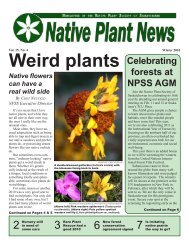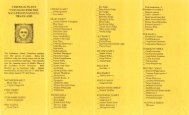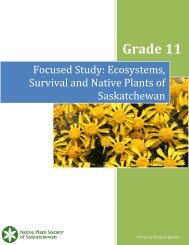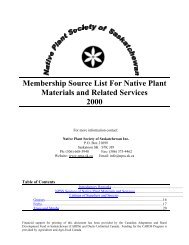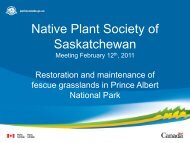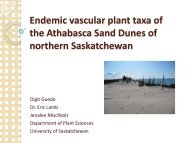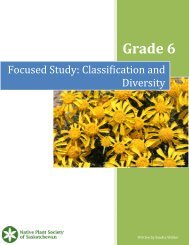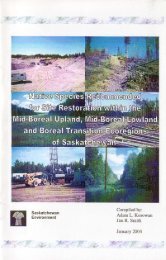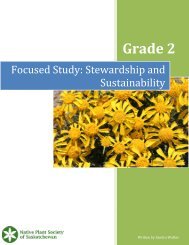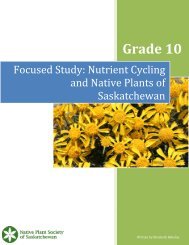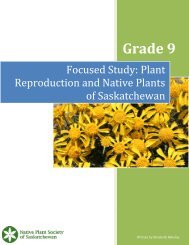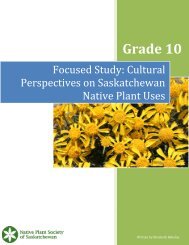Native Plants As Habitat For Wildlife - Native Plant Society of ...
Native Plants As Habitat For Wildlife - Native Plant Society of ...
Native Plants As Habitat For Wildlife - Native Plant Society of ...
Create successful ePaper yourself
Turn your PDF publications into a flip-book with our unique Google optimized e-Paper software.
Loss and Degradation <strong>of</strong> <strong>Native</strong> Mixed-grass Prairie: Implications for Grassland<br />
Bird Conservation in Saskatchewan<br />
Steve Davis<br />
Saskatchewan Wetland Conservation Corporation<br />
Analyses <strong>of</strong> data from the North American Breeding Bird Survey indicate that grassland<br />
bird populations are experiencing the steepest and most consistent declines <strong>of</strong> any avian<br />
group. Widespread loss and degradation <strong>of</strong> prairie habitat have <strong>of</strong>ten been cited as the<br />
primary factors responsible for these declines. Unfortunately, few studies <strong>of</strong> grassland<br />
birds have been conducted in Prairie Canada despite the fact that 70% <strong>of</strong> grassland birds<br />
are declining in Canada and that several endemic grassland bird species reach their<br />
greatest abundance in this region. Here I summarize recent research in an attempt to<br />
identify factors that may contribute to the decline <strong>of</strong> grassland birds in Canada.<br />
Results from grassland bird surveys indicate cropland habitat is least attractive for all<br />
species with the exception <strong>of</strong> the Horned Lark. Several species are <strong>of</strong>ten associated with<br />
hayland and seeded pastures (e.g. Baird’s Sparrow), while other species are mostly<br />
restricted to native pasture (e.g. Sprague’s Pipit). These results suggest that 1) the<br />
conversion <strong>of</strong> native prairie to cropland has likely played a major role in the decline <strong>of</strong><br />
grassland birds and, 2) while forage crops provide habitat for some generalist species,<br />
they do not provide habitat for grassland specialists.<br />
Over-grazing is <strong>of</strong>ten cited as having a deleterious effect on grassland birds because <strong>of</strong><br />
drastic changes in vegetation structure, although some species are associated with heavily<br />
grazed habitats. Indeed, some species are least abundant in heavily grazed pastures and<br />
residual vegetation has been found to be the most important parameter in nest-site<br />
selection models. However, the overall impact that grazing has on grassland bird<br />
populations in Saskatchewan is unknown and may be relatively minor.<br />
Breeding habitat may also be degraded through the process <strong>of</strong> fragmentation. The<br />
increased edge habitat resulting from habitat fragmentation may cause the loss <strong>of</strong> species<br />
that require interior habitats and increase the abundance <strong>of</strong> edge species, including<br />
predators and brood parasitic Brown-headed Cowbirds. Indeed, my research indicates<br />
that grassland specialists are more likely to occur on large pastures and cowbird<br />
parasitism is inversely related to patch size. However, nest success and productivity <strong>of</strong><br />
grassland birds was as high or higher in small native pastures (≤ 65 ha) than in large<br />
pastures (> 256 ha). The results <strong>of</strong> these studies support the contention that the<br />
destruction and fragmentation <strong>of</strong> native grasslands has contributed to the decline <strong>of</strong> some<br />
grassland bird species. Thus conservation <strong>of</strong> Saskatchewan’s native range should be the<br />
province’s highest conservation priority for sustaining endemic grassland bird<br />
populations.<br />
11



